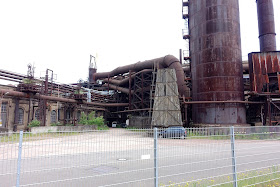Saturday, November 21, 2015
Volklinger Iron Works
Volklinger is a small city along the Saar River in Saarland, Germany. It is about 10 miles west of the center of Saarbrucken. This area was rich in coal and iron ore deposits. As a result coal and iron mines were established here along the Saar River. The The Volklinger iron works were established in 1873 and were in continuous operation from about 1880 until 1986. The town of Volklinger grew up due to employment in the iron works and the mines. The height of employment for the iron works was 17,000 in 1976. The iron works closed in 1986 and it has been preserved as a Wold Heritage Cultural site. I believe it is the only iron works plant from the 19th and 20th century still intact in North America and Europe. The plaque below shows some of the information about it.
The plant is about 14 acres in size. You can take a self-guided tour if you wish. We did not due to time constraints. Below is a view of one side of the works from the parking lot.
The photos below are presented without comment because I don't know the particulars of what we are looking at.
The buildings below were warehouses to hold finished product, mostly pig iron.
The World War II history of the Volklinger iron works is very curious. During the war there were at least 26 air raids by the Royal Air Force and the US Army Air Force aimed at Saarbrucken. Most of the city of Saarbrucken was leveled with many civilians killed and many thousands left homeless. The Volklinger works produced more pig iron than any other plant in Germany and yet not one single bomb fell on it. There are photos from the end of WWII taken by a US GI that show smoke rising from the stacks(http://lostimagesofww2.com/photos/places/saar.php). It is not possible that the allies didn't know of its existence. Strategic bombing was supposed to reduce the German war production. Much of it, however seems to have been vengeance bombing on the populace. Granted, high altitude bombing at that time was not terribly accurate at best but it seems to me that missing a target of this size for three years means that it was off limits for some reason or other. The air force records of the war have been reviewed by others and there is no explanation in them. There are, of course, conspiracy theories but nothing I know of to support them.
During WWII 14,000 slave laborers manned the iron works. An additional 10,000 were used as miners in the mines in the immediate area.
In addition to touring the plant art installations and other cultural events are held on the grounds.
A very interesting place to visit.



















